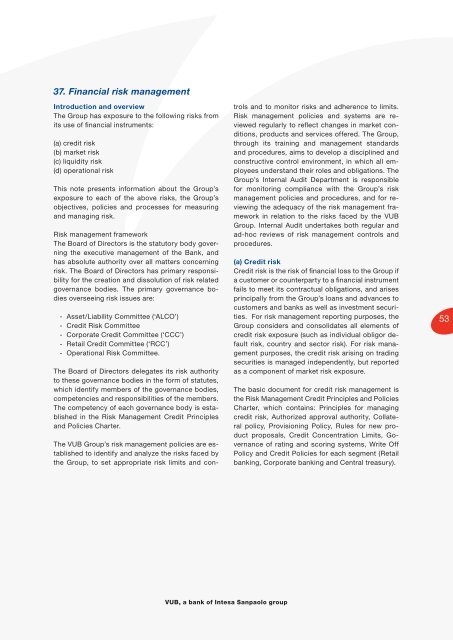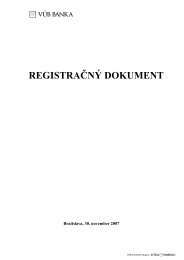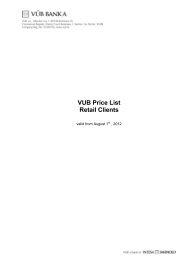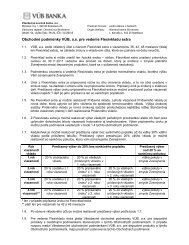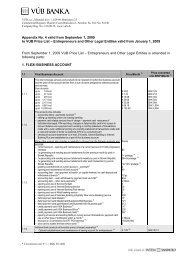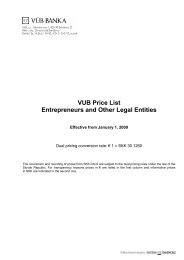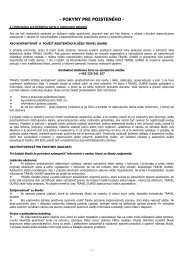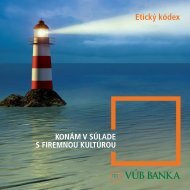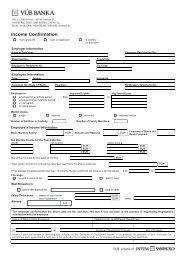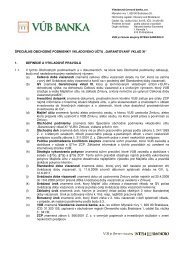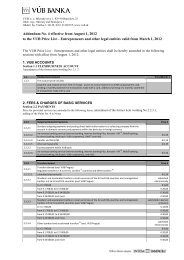Annual Report - VÃB banka
Annual Report - VÃB banka
Annual Report - VÃB banka
Create successful ePaper yourself
Turn your PDF publications into a flip-book with our unique Google optimized e-Paper software.
37. Financial risk management<br />
Introduction and overview<br />
The Group has exposure to the following risks from<br />
its use of fi nancial instruments:<br />
(a) credit risk<br />
(b) market risk<br />
(c) liquidity risk<br />
(d) operational risk<br />
This note presents information about the Group’s<br />
exposure to each of the above risks, the Group’s<br />
objectives, policies and processes for measuring<br />
and managing risk.<br />
Risk management framework<br />
The Board of Directors is the statutory body governing<br />
the executive management of the Bank, and<br />
has absolute authority over all matters concerning<br />
risk. The Board of Directors has primary responsibility<br />
for the creation and dissolution of risk related<br />
governance bodies. The primary governance bodies<br />
overseeing risk issues are:<br />
- Asset/Liability Committee (‘ALCO’)<br />
- Credit Risk Committee<br />
- Corporate Credit Committee (‘CCC’)<br />
- Retail Credit Committee (‘RCC’)<br />
- Operational Risk Committee.<br />
The Board of Directors delegates its risk authority<br />
to these governance bodies in the form of statutes,<br />
which identify members of the governance bodies,<br />
competencies and responsibilities of the members.<br />
The competency of each governance body is established<br />
in the Risk Management Credit Principles<br />
and Policies Charter.<br />
The VUB Group’s risk management policies are established<br />
to identify and analyze the risks faced by<br />
the Group, to set appropriate risk limits and controls<br />
and to monitor risks and adherence to limits.<br />
Risk management policies and systems are reviewed<br />
regularly to refl ect changes in market conditions,<br />
products and services offered. The Group,<br />
through its training and management standards<br />
and procedures, aims to develop a disciplined and<br />
constructive control environment, in which all employees<br />
understand their roles and obligations. The<br />
Group’s Internal Audit Department is responsible<br />
for monitoring compliance with the Group’s risk<br />
management policies and procedures, and for reviewing<br />
the adequacy of the risk management framework<br />
in relation to the risks faced by the VUB<br />
Group. Internal Audit undertakes both regular and<br />
ad-hoc reviews of risk management controls and<br />
procedures.<br />
(a) Credit risk<br />
Credit risk is the risk of fi nancial loss to the Group if<br />
a customer or counterparty to a fi nancial instrument<br />
fails to meet its contractual obligations, and arises<br />
principally from the Group’s loans and advances to<br />
customers and banks as well as investment securities.<br />
For risk management reporting purposes, the<br />
Group considers and consolidates all elements of<br />
credit risk exposure (such as individual obligor default<br />
risk, country and sector risk). For risk management<br />
purposes, the credit risk arising on trading<br />
securities is managed independently, but reported<br />
as a component of market risk exposure.<br />
The basic document for credit risk management is<br />
the Risk Management Credit Principles and Policies<br />
Charter, which contains: Principles for managing<br />
credit risk, Authorized approval authority, Collateral<br />
policy, Provisioning Policy, Rules for new product<br />
proposals, Credit Concentration Limits, Governance<br />
of rating and scoring systems, Write Off<br />
Policy and Credit Policies for each segment (Retail<br />
banking, Corporate banking and Central treasury).<br />
53<br />
VUB, a bank of Intesa Sanpaolo group


